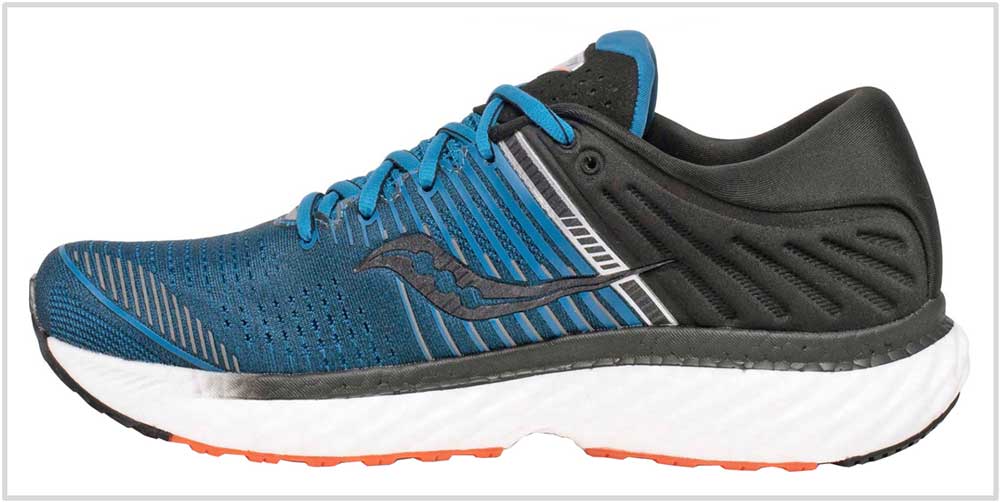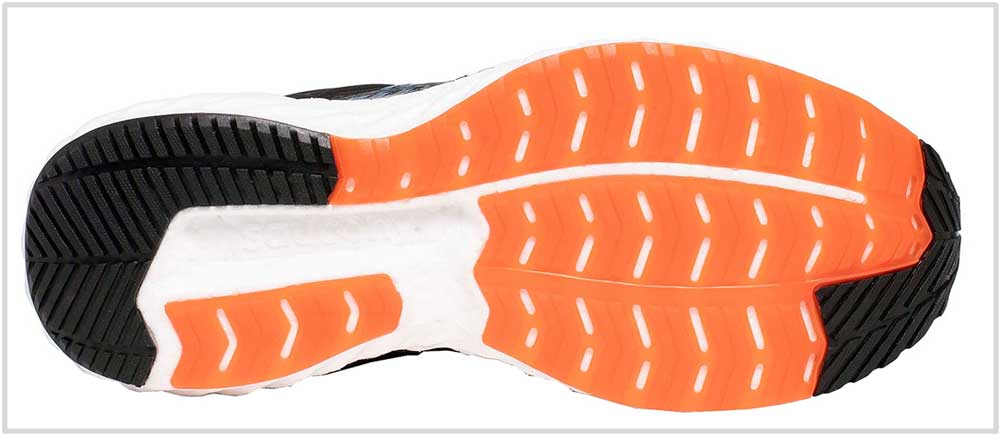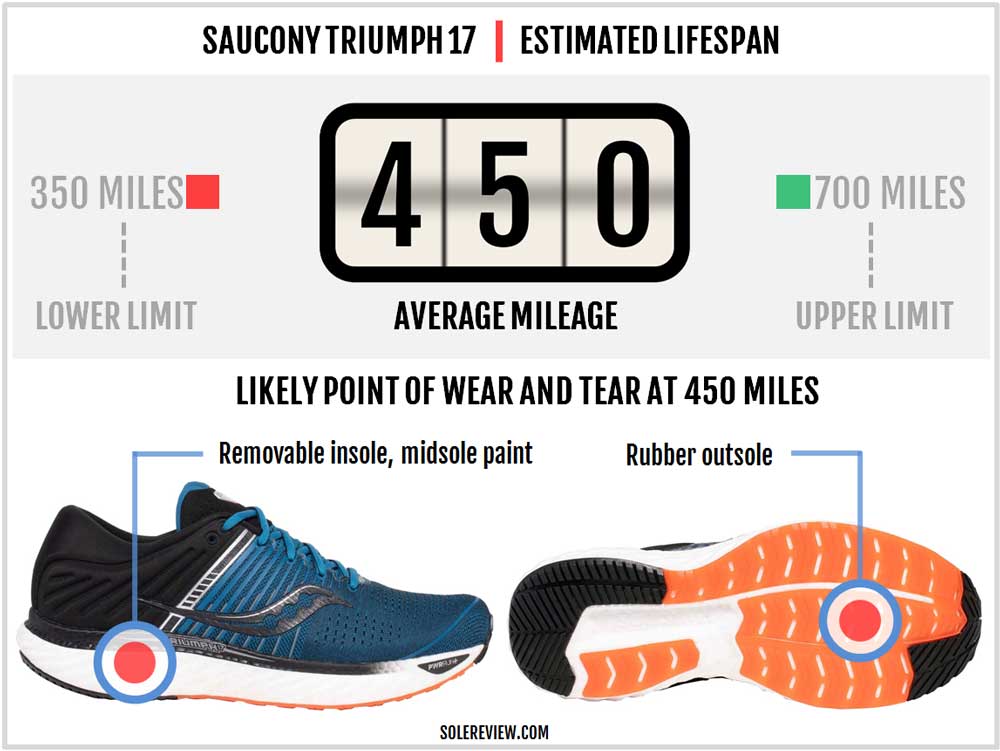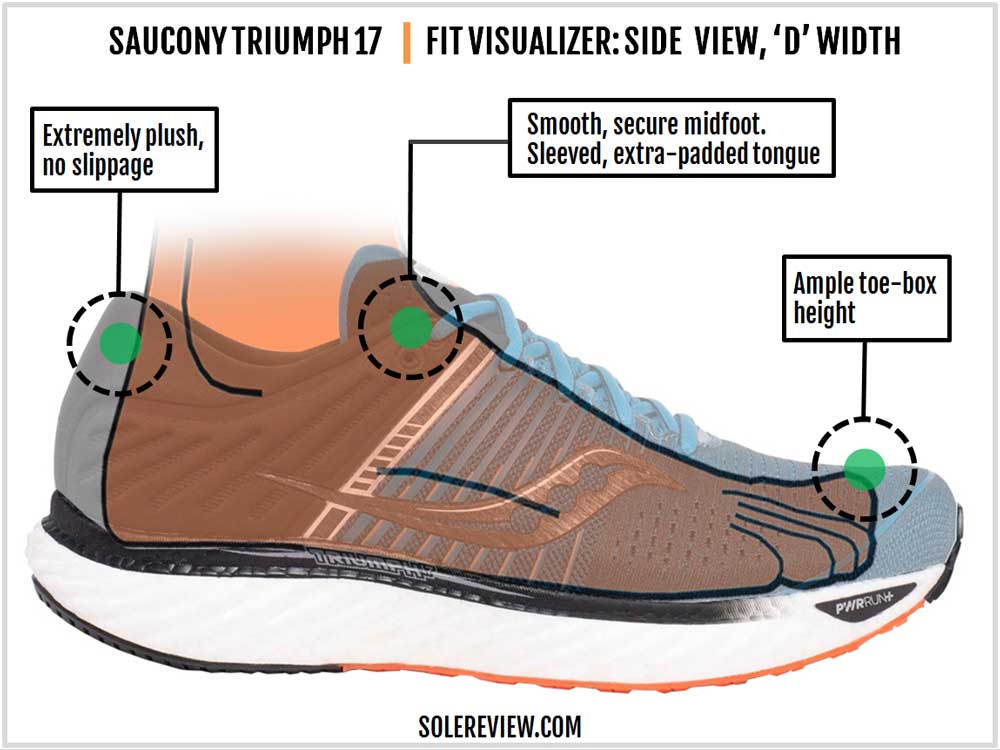INTRODUCTION
The Saucony Triumph 17 is here, but why is it called the 17?
What happened to the whole ISO deal? If the last model was called the Triumph ISO 5, shouldn’t the new shoe have an ISO 6 suffix?
When Saucony released the first generation Triumph ISO with the namesake ISOFIT upper, they thought that they had locked down the perfect midfoot formula. A template that would last an eternity.
Just a year before the Triumph ISO 1, this shoe series was a numbered kind. As a matter of fact, we reviewed the Triumph 9 more than 7 years ago. Gosh, has it been that long? That irritating seam on the arch felt like it was just yesterday.
The Triumph 9 had a midfoot system that was uninspiringly named the ‘Sauc fit’. It used an elastic midfoot fit that, in theory, made the fit adjustable. Back then, even Reebok had something similar. It was called KFS – or the ‘Kinetic Fit System.’
The numbered Triumph kept going till the version 11, after which point it was named the Triumph ISO. In other words, the Triumph 12 evolved into the first ISO model.
The Triumph 17 no longer has the ISOFIT upper, so it makes sense to pick up where the Triumph 11 left off.
Based on the sequence, the Triumph 11 + 5 Triumph ISO models equals the Triumph 16, or the last year’s ISO 5. So the next version should be Triumph 17, and that’s exactly how the 2020 model came to be named.
That was a brief history of the Saucony Triumph – just in case you were racking your brain about the name change.
The naming story aside, what is the new shoe like? After all, the updates here go way beyond a mere upper design change. Doesn’t the Triumph 17 have the new, but unimaginatively named Pwrrun+ midsole?
The 17 is unlike any other Triumph before. It is an excellent running shoe – provided you tap into the shoe’s strengths. If there was ever an ideal for a high-mileage runner, the T-17 comes pretty close.
Just like the Everun, the midsole is made of expanded Polyurethane. However, that’s where the similarity ends. The Pwrrun+ material is softer, snappier, and lighter than before. These updates make the new Triumph the most comfortable version to date, and the same is true for the upper.
The upper has a higher level of plushness and reverts to a traditional design sans the ISOFIT saddle.
In addition to being an ounce lighter, the Triumph 17’s retail price gets a $10 shave – just enough for a cup of coffee and breakfast.
Our verdict? This shoe is the real deal; read on.
THE TRIUMPH 17 vs. TRIUMPH ISO 5
The Triumph 17 is a much softer shoe than the ISO 5. The firmer Everun requires a certain amount of effort to coax the responsiveness out of the midsole. That’s not how the Pwrrun+ works.
The 17 is noticeably soft right out of the box. It isn’t just about the material; the midsole adds more stack height as well. The Triumph ISO 5 had a rear and front thickness of 28 mm and 20 mm. In comparison, the 17 comes in at 33 mm/25 mm – that’s an 8 mm heel-to-toe offset, by the way.
So if you’re thinking that the 17 looks thicker, you’re not imagining it – the midsole does have a lot more foam this year. That extra thickness and the new foam translates into a ride experience that is soft yet has a pop that was missing on the Everun.
The outsole is still made of the durable ‘Crystal’ rubber and introduces a new geometry that makes the midfoot softer. The 17 has greater flexibility and is an ounce lighter too.
The new upper comes with a slew of updates, mostly functional. The midfoot no longer has ISOFIT with its split lacing; the traditional upper is built using a thicker engineered mesh.
The change of lacing and the upper material makes the Triumph 17 narrower-fitting than the ISO 5. The added plushness makes the interiors warmer than the exceptionally airy ISO 5.
There’s one performance aspect that’s of interest. By being firmer and lower to the ground, the ISO 5 was relatively ‘faster’ and more supportive in comparison.
The ISO 5’s full-spread outsole layout was also a factor – it covered the underside without exposing a lot of the midsole foam. On the other hand, the 17’s midfoot area leaves a lot of the soft midsole exposed.
THE RIDE EXPERIENCE
When reviewing a running shoe that is a part of an established series, we generally encounter two recurring themes. The first – and the more common kind usually involves an otherwise good running shoe that has been ruined by an update.
The second theme is about redemption, a positive situation where a new shoe claws back some of its lost glory. A return to form, if you will. Somewhere between those two themes are shoes that get minor and non-newsworthy updates.
In what is a rare occurrence, the Saucony Triumph 17 falls in neither of the above two categories.
The Saucony Triumph was never a shoe with a soft ride, and our observation includes both the ISOFIT and non-ISO versions. The ride was always tinged with some firmness, be it the Triumph 9/10/11 with their SRC crash pads or the newer Everun versions.
Even the upper plushness is a relatively new phenomenon on the Triumph, something that began with the first generation Triumph ISO.
In more ways than one, the Saucony Triumph 17 is a perfect example of a generational shift within an existing series.
We’re not just talking about the newly acquired softness and responsiveness here. The 2020 midsole is substantially thicker and marginally wider – a new template that is likely going to be the new standard for Saucony’s premium neutral trainer. Till something newer comes along, that is.
Though the Pwrrun+ is molded using expanded Polyurethane, it differs vastly from its predecessor, Everun. It is ‘fluffier’ and less dense than the previous-gen foam. The new midsole is easier to compress than Everun, and it snaps back just as quickly.
In other words, it is softer and more responsive at any speed. Naturally, running faster will result in a higher rate of responsiveness due to the faster compression cycle. That being said, most of the Pwrrun+’s cushioning niceties are available even at leisurely speeds – something that the firmer Everun did not deliver.
And that’s the appropriate use-case for the Triumph 17 – a long-distance cruiser for relaxed ( 10 min/mile or 6 min/km or slower) runs.
Sure, you can push higher running speeds (7 min/mile or under 5 min/km or faster) in this shoe without any issues. But that’s not where the 17’s strengths lie.
We also have to keep in mind that the new midsole is uniformly thicker by 5 mm and has a wider heel. With that kind of volume, comfortable easy runs are the Triumph’s wheelhouse.
This is also a shoe that you can wear during the colder months – the expanded Polyurethane midsole is highly resistant to temperature swings and does not firm up like the Nike React and traditional EVA-based midsoles. On a side note, if you’re planning to do hardcore winter running, this guide should be help.
Everun isn’t advertised on the Triumph 17, but the shoe has it in the form of a topsole. There’s a removable insole as well – both these layers give you a nice, cushy step-in feel. The picture you see here is that of the redesigned Everun topsole with a different molding than before – even the Ride ISO 2 uses the same kind.
The added stack heights create a running shoe that is also very comfortable for forefoot strikers. 25 mm of Pwrrun+ foam means that you’ll get similar levels of springy cushioning that one gets under the rearfoot.
Transitions are very smooth, though not as quick as the ISO 5. The uniform spread of foam under the foot results in a consistent feel, but this is a soft shoe. We like what Saucony has done with the forefoot – there’s a groove splitting the outsole, not unlike Asics’s ‘Guidance line.’
Though the outsole is made of the same crystal rubber as before, the new geometry exposes more midsole foam. The thin outsole still works well with the midsole, yet the updated layout makes the transitions slightly slower through the midfoot.
The T-17 is surprisingly flexible for a shoe this stacked. So unlike shoes such as the New Balance 1080 or the Hoka Clifton, there’s no ‘roll-off’ effect here. On the Triumph, you have to work your way through the forefoot gait cycle.
The wide base and the single-density midsole make the ride very neutral along with fair levels of stability. You won’t get the supportive ride of the much firmer ISO 5, but there’s no reason to worry either.
If the Freedom ISO 3 were already in the market, that would have been an ideal shoe to rotate along with the Triumph. But it’s not going to be here until January 2020.
For now, the versatile Kinvara 10 is your lighter (and faster) shoe option. The Saucony Type A9 is perfect for those all-out 5K runs and races. The New Balance 890V7 and 1400V6 are also great fast training and race-day shoes too, respectively.
If you want your speed trainer to be lightweight and cushioned, you can’t go wrong with the Reebok Floatride Run Fast.
IS THE SAUCONY TRIUMPH 17 DURABLE?
By combining an e-TPU midsole with a crystal rubber outsole, the Triumph is at par with the industry gold standard – the power combo of adidas Boost and Continental outsole.
There’s not much that can go wrong with the T-17’s upper either. The mesh is thick, and the inner sleeve acts as a reinforcement layer. A mileage of 450 miles is easily doable, potentially more.
THE UPPER DESIGN AND FIT
The ISOFIT strapping system is gone. We were never a fan of that design starting with the ISO 1, so that isn’t a loss.
But that’s not the only update worth discussing; the new upper is a complete revamp from the heel to toe.
There are two things one notices upon lacing up the 17.
First, it is a lot snugger than the last version. While the thicker mesh has a role to play, the first row of lacing exerts a greater influence on the fit than the ISO 5.
Unlike the previous Triumph, the first lacing row does not pass through the 3rd loop on the front. The T-17 no longer has that loop so both ends are directly connected. So you have to be careful how much pressure you apply on the lacing – another side effect is that the upper will appear bunchy if tied too tight.
The toe-box is a bit pointier and narrower than the ISO 5 due to the mesh. That being said, the vertical space is just right. Even with the changes, we’d still go true to size on the T-17.
Go easy on the laces if you value forefoot room. And if you feel that the upper has ‘stretched’ after a while, it’s most likely the front row of laces loosening a bit.
If you have wide feet and found the last year’s ISO 5 a perfect fit, then it’s worthwhile upsizing to a 2E (wide) on the Triumph 17.
The overly plush heel collar is the second thing that’s new about the 17. This isn’t to say that the ISO 5 didn’t have a plush collar; however, the 17’s collar is softer and sits slightly higher over the Achilles.
There are no concerns with the quality of the heel grip. A hard internal counter in the lower half of the heel cups the foot securely.
It’s also worth noting that the foam used inside the collar is low-density, so it fits gently without creating pressure points. There’s a row of heel-lock lacing available but we doubt you’ll ever use it.
The tongue gets a similar plush treatment – the flap is softer due to the new design and materials. Foam has been liberally used to pad the insides so the tongue effectively filters the top-down lacing pressure. A gusset/sleeve inside makes the lining smooth while locking down the tongue in place.
The laces go from flat to soft round types – the kind often seen on Brooks running shoes and premium Mizunos. They are soft to the touch and have some amount of stretch.
Some runners might find the plump heel and tongue an overkill, but that’s a personal choice. But if you ask us, the newfound plushness is a good fit with the soft responsiveness that has been reworked into the midsole.
At many levels, the Triumph 17 competes with the Brooks Glycerin 17 on upper plushness – it even outdoes the G-17 in a few areas. This is a cushy upper that requires no break-in period.
Fused midfoot overlays take place of the ISOFIT lacing system. The Saucony logo and the high-density printing details add some structure to the otherwise all-mesh upper.
Compared to the ultra-breathable Triumph ISO 5, the 17 runs warm. After all, the mesh is a lot thicker than the last model. Just know that this comment is relative to the ISO 5. When compared to the average running shoe, the Triumph 17 isn’t what one would describe as a warm shoe. The slits built into the forefoot function as air vents.
Reflectivity gets an upgrade. Quite timely, we must add, given that we recently called out the decreasing levels of reflectivity. In addition to the existing strip over the heel, the Triumph 17 adds a couple of reflective bits over the forefoot.
PROS AND CONS
The new Pwrrun+ foam hits the sweet spot between cushioning softness and responsiveness – a quality that results in long-distance comfort without any energy-sapping mushiness.
Like the Everun, Pwrrun+ is an e-TPU midsole – that means it doesn’t stiffen in the cold and is resistant to fatigue. Add to that the Crystal rubber outsole, and what you get is a very durable package.
While fast runs (7 min/mile or 5 min/km or quicker) aren’t best accomplished with the Triumph 17, it noticeably has more pop than, say, the New Balance 1080.
If you felt that the earlier Triumph lacked upper plushness, you’re in for a treat. The collar and tongue feel incredibly soft and plush; the non-ISOFIT upper feels smoother (and snugger) than before.
The newly added reflective bits are appreciated as well.
SHOES SIMILAR TO THE TRIUMPH 17, AND A COMPARISON WITH THE ADIDAS BOOST
Some runners may want to know how the Triumph 17 compares with adidas Boost, so we’ll cover that first. Both the Solarglide 19 and SolarBoost 19 compare (and the UltraBoost to a certain extent) with the Triumph. But for the sake of brevity, we’ll pick the SolarBoost ’19.
When Boost made its debut five years ago, we wrote a glowing review of the then-new foam that sent EVA and PU to the bench. Since then, a lot has happened in the footwear industry. Even Reebok, an adidas subsidiary has a better thing going with the Floatride foam.
The composition of the Boost foam hasn’t changed since its debut. Thus, the SolarBoost 19 has the familiar Boost experience that delivers a soft cushioning that is concentrated mostly under the rearfoot.
The Saucony Pwrrun+ is a tightly sprung version of the adidas Boost. It is more responsive – meaning it is quicker to snap back into its original shape than the Boost. Both foams are supremely comfortable cushioning materials; it is just that Saucony’s version has a little more ‘life’ in them. Boost has a relatively easygoing feel to it.
When you compare both the shoes, the adidas SolarBoost 19 is more ‘business-like’ versus the very plush Triumph. The adidas shoe has a thinner midsole, a firmer Continental outsole and a rigid Torsion shank that extends from the midfoot to the front and rear. The outsole does not expose a lot of Boost foam either.
This makes the SolarBoost a cushioned yet faster-feeling running shoe than the Triumph 17. Also, the adidas shoe does not have a lot of upper plushness. The forefoot is snug like the Saucony. To sum up, both are functionally different running shoes. One is an ultra-plush cruiser while the SolarBoost 19 is slightly more performance-oriented.
The New Balance 1080V10 is a max-cushioned option that competes directly with the Triumph. The midsole feels ‘deeper’ than the Triumph and not as bouncy. The upper is more minimal and lacks the creature comforts of the Saucony.
A traditional, EVA-foam based ride experience can be had with the Asics Gel Nimbus 22 and the Brooks Glycerin 17. The plushness of the Glycerin’s upper compares with the Triumph. Underneath, the ride is comfortable yet muted in its cushioning delivery.
The Brooks Levitate 3 has a unique ride – one which is vertically responsive due to the hard outer skin of the soft midsole. There’s an excellent sense of energy return but at the cost of higher weight.
There are a few other cushioned running shoes that work for high-mileage runs. The Hoka Clifton 6 is a strong contender, and so are lightweight shoes like the Skechers MaxRoad 4 Hyper and the Nike Epic React Flyknit 2.
THE TRIUMPH 17 vs. RIDE ISO 2
Pick the Ride ISO 2 if you want a daily trainer that is an ounce lighter and more versatile. The noticeably firmer and lower profile midsole is better for faster paces than the Triumph.
When seen from a long-distance comfort and overall fun perspective, the more expensive Triumph is the superior product.
Do you own this shoe? Improve this review by sharing your insights – submit a review here.















